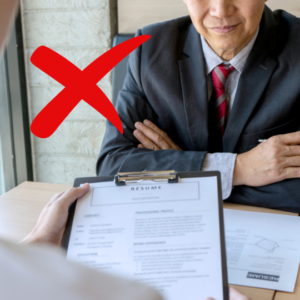Body language plays a crucial role in job interviews. It can convey confidence, professionalism, and interest, or, conversely, nervousness, disinterest, and unpreparedness. Understanding and mastering body language can significantly impact your chances of landing the job. This guide will provide comprehensive insights into how you can use Body Language in Job Interviews.
Why Body Language Matters in an Interview
Body language is a powerful form of non-verbal communication that can significantly impact the outcome of a job interview. It encompasses a range of physical behaviors, including posture, facial expressions, gestures, and eye contact. These cues can convey confidence, enthusiasm, and professionalism, or, conversely, nervousness, disinterest, and insecurity. Here’s why body language matters in an interview and how you can use it to your advantage.

1. First Impressions Count
The moment you walk into the interview room, your body language starts communicating on your behalf. A confident stride, a firm handshake, and a friendly smile can set a positive tone from the outset. Interviewers often form initial impressions within the first few seconds, and positive body language can help create a favorable one.
Example: When you greet the interviewer with a firm handshake and a smile, you immediately project confidence and approachability, making a strong first impression.
2. Conveys Confidence and Competence
Confident body language, such as maintaining good posture and steady eye contact, can suggest that you are self-assured and competent. This is especially important in job interviews where employers are looking for candidates who can handle the responsibilities of the role with assurance.
Example: Sitting upright with your shoulders back and making consistent eye contact while answering questions shows that you are confident in your abilities and what you bring to the table.
3. Demonstrates Engagement and Interest
Engaging body language, like nodding in agreement and leaning slightly forward, indicates that you are actively listening and interested in the conversation. This can make you appear more enthusiastic and eager about the opportunity.
Example: When the interviewer is explaining the role, leaning slightly forward and nodding in agreement shows that you are genuinely interested and paying close attention.
4. Reinforces Verbal Communication
Your body language can complement and reinforce what you are saying verbally. Gestures can help illustrate your points, and facial expressions can convey your enthusiasm and sincerity. This alignment between your words and non-verbal cues can make your communication more effective and believable.
Example: While discussing a project you led, using hand gestures to describe the scope and impact of the project can make your explanation more vivid and convincing.
5. Builds Rapport
Positive body language can help build rapport with the interviewer. Mirroring the interviewer’s body language subtly and maintaining an open posture can create a sense of connection and mutual respect.
Example: If the interviewer leans forward when discussing a key point, subtly mirroring this action can help build a subconscious connection, making the conversation feel more natural and engaging.
6. Avoids Negative Impressions
Negative body language, such as crossing your arms, fidgeting, or avoiding eye contact, can send the wrong signals. It can make you appear defensive, anxious, or disinterested, which can detract from the positive impression you want to make.
Example: Avoiding eye contact or frequently looking around the room can make you seem distracted or disinterested while crossing your arms can make you appear closed off or defensive.
Common Body Language Mistakes to Avoid
Even if you prepare thoroughly for your interview, certain body language mistakes can undermine your performance. Being aware of these common pitfalls and actively working to avoid them can help you present yourself in the best possible light.
1. Fidgeting
Fidgeting with your hair, pen, or any other object can be distracting and may signal nervousness or a lack of focus. It can make you appear unsettled and anxious, detracting from the professionalism you want to convey.
How to Avoid: Keep your hands relaxed on your lap or the table. Practice sitting still during mock interviews to become more aware of your movements.
2. Crossing Arms

Crossing your arms can come across as defensive or closed-off, suggesting that you are not open to communication. It can create a barrier between you and the interviewer, making you seem unapproachable.
How to Avoid: Keep your arms relaxed and open. If you’re unsure where to place them, resting them gently on the table or your lap is a good option.
3. Avoiding Eye Contact
Failing to maintain eye contact can be perceived as a lack of confidence or dishonesty. It may give the impression that you are not fully engaged or are hiding something.
How to Avoid: Practice maintaining natural, intermittent eye contact. Look at the interviewer when they are speaking and when you are responding, but don’t stare.
4. Poor Posture
Slouching or leaning back in your chair can indicate a lack of interest or confidence. It can make you appear less engaged and less professional.
How to Avoid: Sit up straight with your shoulders back and feet flat on the floor. This posture exudes confidence and attentiveness.
5. Overusing Gestures
While gestures can help emphasize your points, overusing them can be distracting and make you appear overly animated or nervous. It can detract from the content of what you’re saying.
How to Avoid: Use hand gestures sparingly and purposefully. Practice your responses to ensure your gestures complement rather than overwhelm your speech.
6. Excessive Nodding
Nodding occasionally to show understanding is good, but excessive nodding can make you seem overly eager to please or insincere. It can be perceived as a lack of critical thinking.
How to Avoid: Nod in moderation. Focus on active listening and nodding naturally in response to key points.
7. Touching Your Face
Touching your face, including rubbing your eyes or scratching your nose, can be seen as a sign of nervousness or dishonesty. It can also be distracting to the interviewer.
How to Avoid: Keep your hands away from your face. Practice interview scenarios to become aware of and reduce these habits.
8. Looking Around the Room
Constantly looking around the room or at your surroundings can indicate disinterest or distraction. It can make the interviewer feel that you are not fully present in the conversation.
How to Avoid: Focus on the interviewer and maintain eye contact. If you need to gather your thoughts, a brief moment of looking away is fine, but avoid doing so frequently.
9. Yawning
Yawning during an interview, even if you’re tired, can be interpreted as a lack of interest or boredom. It is one of the quickest ways to make a poor impression.
How to Avoid: Ensure you are well-rested before your interview. If you feel a yawn coming on, try to suppress it or excuse yourself briefly if necessary.
How to Correct Body Language Mistakes
Self-Awareness
The first step to correcting body language mistakes is becoming aware of them. Conduct mock interviews or videotape yourself practicing to identify any habits that need adjustment.
Feedback

Seek feedback from friends, family, or mentors. They can provide an outside perspective on your body language and offer constructive suggestions for improvement.
Practice
Regular practice can help you develop better body language habits. The more you practice, the more natural positive body language will become.
Preparing for Your Interview
Preparing for a job interview involves more than just rehearsing answers to common questions. Your body language plays a crucial role in how you are perceived. Here are some strategies to help you prepare and ensure your non-verbal cues convey confidence and professionalism.
1. Practice Makes Perfect
Rehearse your responses to typical interview questions, paying close attention to your body language. Practice maintaining good posture, steady eye contact, and appropriate hand gestures. This will help you become more aware of your non-verbal cues and ensure they align with your verbal responses.
Example: Stand in front of a mirror or record yourself answering questions. Evaluate your posture, facial expressions, and gestures, and make adjustments as needed.
2. Mock Interviews
Participating in mock interviews can simulate the actual interview environment and help you practice your body language in a realistic setting. Seek feedback from the person conducting the mock interview to identify areas for improvement.
Example: Arrange a mock interview with a friend, mentor, or career coach. Focus on how you enter the room, shake hands, sit, and respond to questions, then discuss any body language adjustments that may be needed.
3. Relaxation Techniques
Interviews can be nerve-wracking, but practicing relaxation techniques can help you stay calm and composed. Deep breathing, visualization, and mindfulness exercises can reduce anxiety and prevent nervous habits, such as fidgeting.
Example: Before the interview, take a few minutes to practice deep breathing exercises. Inhale slowly through your nose, hold for a few seconds, and exhale slowly through your mouth. This can help calm your nerves and ensure you enter the interview with a clear mind.
4. Dress Appropriately
Your attire can influence your confidence and how you are perceived. Dressing professionally and comfortably can boost your self-assurance and positively impact your body language.
Example: Choose an outfit that is appropriate for the company’s dress code and that makes you feel confident. Ensure your clothes are clean, well-fitted, and free of distractions.
5. Arrive Early
Arriving early gives you time to acclimate to the interview environment and compose yourself. It allows you to make any last-minute adjustments to your appearance and mindset, ensuring you are fully prepared when the interview begins.
Example: Aim to arrive at least 10-15 minutes early. Use this time to review your notes, practice deep breathing, and visualize a successful interview.
6. Mind Your Entrance
Your entrance sets the tone for the interview. Walk in with a confident stride, make eye contact with the interviewer, and offer a firm handshake. These initial actions can create a positive first impression.
Example: When called for your interview, stand up straight, walk confidently to the interviewer’s desk, make eye contact, smile, and extend your hand for a handshake.
7. Body Language During the Interview
Throughout the interview, be conscious of your body language. Maintain good posture, make appropriate eye contact, use controlled gestures, and mirror the interviewer’s body language subtly to build rapport.
Example: If the interviewer leans forward while asking a question, subtly mirror this action to show engagement. Avoid crossing your arms or fidgeting, and keep your movements deliberate and purposeful.
Conclusion
Mastering body language is essential for conducting job interviews. By maintaining appropriate eye contact, good posture, and using effective gestures, you can project confidence and professionalism. Remember, practice is key to improving your non-verbal communication skills. For comprehensive career guidance and interview preparation, consider Prepmagic, the best platform to build your confidence and enhance your interview skills.
By focusing on these body language tips, you’ll be well on your way to making a positive and lasting impression in your next job interview.
